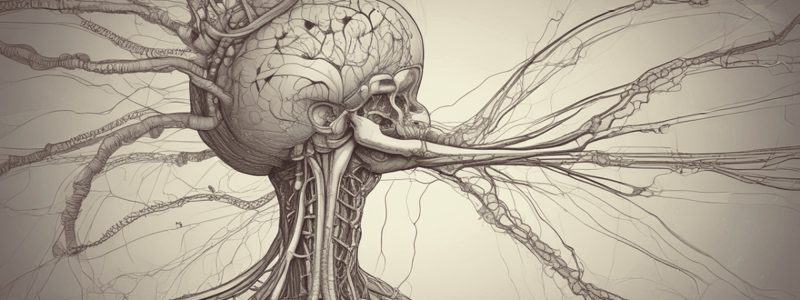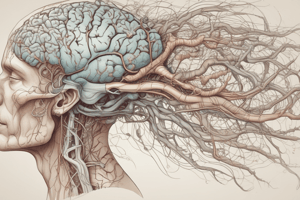Podcast
Questions and Answers
Which system is responsible for maintaining homeostasis?
Which system is responsible for maintaining homeostasis?
- Autonomic nervous system (correct)
- Somatic nervous system
- Peripheral nervous system
- Central nervous system
What type of nerves primarily come from sensory receptors and travel into the central nervous system?
What type of nerves primarily come from sensory receptors and travel into the central nervous system?
- Motor neurons
- Afferent nerves (correct)
- Efferent nerves
- Sensory neurons
Which type of pain is characterized as sharp, immediate, and acts as a warning signal to respond to a harmful stimulus?
Which type of pain is characterized as sharp, immediate, and acts as a warning signal to respond to a harmful stimulus?
- Neuropathic pain
- First pain (correct)
- Chronic pain
- Second pain
What protects the central nervous system from toxic injury?
What protects the central nervous system from toxic injury?
Which type of fibers carry general sensations such as light touch and vibration?
Which type of fibers carry general sensations such as light touch and vibration?
What is the function of the spinothalamic tract in the spinal cord?
What is the function of the spinothalamic tract in the spinal cord?
Which component of the peripheral nervous system provides movement and sensation to a specific region of the body?
Which component of the peripheral nervous system provides movement and sensation to a specific region of the body?
What is a characteristic of the somatic nervous system?
What is a characteristic of the somatic nervous system?
What is the main structure that forms the superior boundary of the carpal tunnel?
What is the main structure that forms the superior boundary of the carpal tunnel?
Which of the following muscles is NOT supplied by the median nerve?
Which of the following muscles is NOT supplied by the median nerve?
What is the characteristic feature of Charcot-Marie-Tooth Disease (CMT)?
What is the characteristic feature of Charcot-Marie-Tooth Disease (CMT)?
What is the primary pathogenic mechanism of Myasthenia Gravis?
What is the primary pathogenic mechanism of Myasthenia Gravis?
What is the primary effect of acetylcholinesterase inhibitors in Myasthenia Gravis?
What is the primary effect of acetylcholinesterase inhibitors in Myasthenia Gravis?
What is the characteristic symptom of Charcot-Marie-Tooth Disease (CMT) owing to muscular imbalance?
What is the characteristic symptom of Charcot-Marie-Tooth Disease (CMT) owing to muscular imbalance?
What is the typical pattern of symptom progression in Charcot-Marie-Tooth Disease (CMT)?
What is the typical pattern of symptom progression in Charcot-Marie-Tooth Disease (CMT)?
What is the primary goal of plasmapheresis in Myasthenia Gravis?
What is the primary goal of plasmapheresis in Myasthenia Gravis?
What is the typical clinical feature of Myasthenia Gravis that improves with rest?
What is the typical clinical feature of Myasthenia Gravis that improves with rest?
What is the mechanism of action of IV immunoglobulin in Myasthenia Gravis?
What is the mechanism of action of IV immunoglobulin in Myasthenia Gravis?
Which of the following is NOT a risk factor for diabetic peripheral neuropathy?
Which of the following is NOT a risk factor for diabetic peripheral neuropathy?
What is the primary mechanism of nerve damage in diabetic peripheral neuropathy?
What is the primary mechanism of nerve damage in diabetic peripheral neuropathy?
What is the typical order of symptom progression in diabetic peripheral neuropathy?
What is the typical order of symptom progression in diabetic peripheral neuropathy?
What is the most common preceding infection in Guillain-Barré syndrome?
What is the most common preceding infection in Guillain-Barré syndrome?
What is the primary mechanism of autoimmune response in Guillain-Barré syndrome?
What is the primary mechanism of autoimmune response in Guillain-Barré syndrome?
What is the main medication used to treat Guillain-Barré syndrome?
What is the main medication used to treat Guillain-Barré syndrome?
What is the typical timeframe for functional recovery in Guillain-Barré syndrome?
What is the typical timeframe for functional recovery in Guillain-Barré syndrome?
What is the primary cause of carpal tunnel syndrome?
What is the primary cause of carpal tunnel syndrome?
What is the most common compressive focal mononeuropathy seen in clinical practice?
What is the most common compressive focal mononeuropathy seen in clinical practice?
What is the congenital predisposition that contributes to the development of carpal tunnel syndrome?
What is the congenital predisposition that contributes to the development of carpal tunnel syndrome?
Flashcards are hidden until you start studying
Study Notes
Peripheral Nervous System
- Direct extension of the central nervous system that monitors and reacts to external stimuli
- Two components: autonomic nervous system (ANS) and somatic nervous system
- Autonomic nervous system (ANS):
- Not regulated by conscious control
- Helps maintain homeostasis
- Automatically adjusts the activity of the sympathetic and parasympathetic nervous systems to match the body's needs
- Somatic nervous system:
- Afferent (sensory) nerves: primarily come from sensory receptors and travel into the central nervous system
- Efferent (motor) nerves: travel from the CNS to primarily muscle for motor activation
Components of Peripheral Nervous System
- Cranial nerves
- Spinal nerves:
- Provide movement and sensation to a specific region of the body
- Carry sympathetic, parasympathetic, motor, and sensory information
Sensory Receptors
- General sensation: light touch and vibration
- Carried by the dorsal columns in the spinal cord
- We adapt to these sensations more rapidly than heat and pain because they are carried by faster fibers
- Pain:
- Highly subjective
- Carried by the spinothalamic tract in the spinal cord
- "First pain" - sharp, immediate, a "good" thing that acts as a warning signal to respond to a harmful stimulus
- "Second pain" - delayed, longer-lasting sensation, chronic "bad" pain that comes from damage or pathology that remains even after the stimulus is gone
- Temperature:
- Carried by the spinothalamic tract in the spinal cord
- Interestingly, both pain and temperature can be sensed by the same receptors
- Extreme heat or extreme cold can trigger the sensation of pain
Diabetic Peripheral Neuropathy
- Most common complication of diabetes
- Duration and severity of hyperglycemia and metabolic syndrome are the 2 most important risk factors in patients with type 1 or type 2 diabetes
- Distal symmetric polyneuropathy:
- Can involve sensory, motor, and autonomic neurons
- Sensory neurons are more susceptible to damage than motor neurons because most sensory neurons are unmyelinated
- Pathophysiology:
- Distal portions of long sensory axons degenerate
- Ischemia due to microvascular damage from hyperglycemia
- Buildup of advanced glycation end products (AGEs) contributes to oxidative stress and damages nerves
- Clinical manifestations:
- Progressive loss of sensation
- Negative symptoms (numbness, loss of balance)
- Positive symptoms (tingling, pain)
- Symptoms start distally in the toes and feet, and positive symptoms are usually worse at night
Guillain-Barré Syndrome
- Autoimmune destruction of the schwann cells surrounding peripheral nerves
- Post-infectious autoimmune neuropathy
- ~ 70% of patients have a preceding infection
- Campylobacter jejuni is a common organism that can trigger GBS
- Molecular mimicry:
- One of the main mechanisms through which infectious (or chemical) agents produce an autoimmune response
- Similarities between foreign peptides and "self" peptides cause activation of T/B cells
- Clinical manifestations:
- Symmetric, ascending weakness is the hallmark, typically begins in the legs
- Numbness
- Tingling
- Weakness that can progress to paralysis
- Symptoms generally progress over a period of 2 weeks
- Diagnosis:
- Typically, a clinical diagnosis (preceding infection with characteristic presentation, etc.)
- EMG and nerve studies can be helpful if unclear
- Treatment:
- Start with supportive care
- Monitor for progression
- Monitor respiratory status
- Monitor blood pressure and heart rate
- DVT prophylaxis
- Pain control
- Main medication for GBS is IVIG (Intravenous immunoglobulin)
Carpal Tunnel Syndrome
- Common condition causing numbness, tingling, and pain in the hand and forearm
- Really an anatomic issue, not a "physiologic" one
- Median nerve is compressed as it travels through the wrist (the carpal tunnel)
- Compression of the median nerve leads to ischemia and mechanical disruption
- Presents as pain, paresthesia, and less commonly, weakness in the median nerve distribution
- Traversing the carpal tunnel:
- The carpal tunnel is formed by the transverse carpal ligament superiorly with the carpal bones inferiorly
- As the median nerve crosses the wrist, it passes through the carpal tunnel along with nine flexor muscle tendons
Charcot-Marie-Tooth Disease (CMT)
- Group of hereditary disorders that cause peripheral neuropathy in both sensory and motor neurons
- Often abnormalities in the axons or production/maintenance of the myelin sheath
- The "demyelinating" disorder of the peripheral nervous system
- Over time, neurons degenerate leading to muscle weakness/atrophy
- Affects longer nerves first
- Symptoms typically begin in the feet/lower legs and then the fingers, hands, and arms
- High arched feet due to muscular imbalance (from atrophy)
Myasthenia Gravis
- Autoimmune disorder of the neuromuscular junction that manifests as progressive skeletal muscle weakness and fatigability
- Pathogenesis:
- The body makes autoantibodies to the acetylcholine receptor
- The antibodies bind to the receptor and interfere with neurotransmitter function
- There are fewer acetylcholine receptor sites available when an action potential arrives
- Clinical manifestations:
- Generalized proximal limb weakness and fatigability with repeated activities → this improves with rest
- Drooping of eyelids (ptosis)
- Double vision (diplopia)
- Flattened smile
- Difficulty chewing and/or swallowing
- If severe: difficulty breathing
- Treatment:
- Acetylcholinesterase inhibitors
- Block the enzyme that's breaking down Ach = more Ach around to bind to receptors that are still functional
- It is also used to diagnose MG by showing improvement of muscle weakness with use
- Immunosuppressants like corticosteroids
- Plasmapheresis to remove autoantibodies from the blood
- IV immunoglobulin: give other antibodies that block the anti-AChR antibodies
Studying That Suits You
Use AI to generate personalized quizzes and flashcards to suit your learning preferences.




